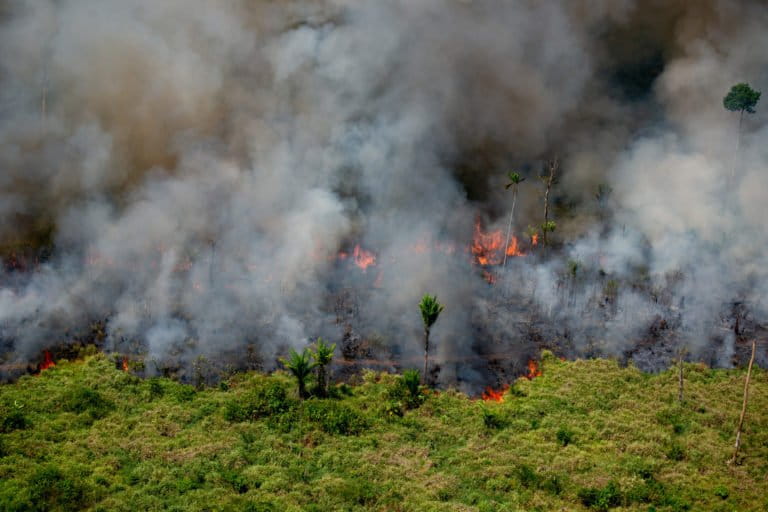- The aerial images — captured by photographer Christian Braga over the states of Rondonia, Amazonas, and Mato Grosso from August 16-18, 2020 — show fires burning through recently deforested areas, agricultural areas, degraded forests, and on the edges of dense tropical forests.
- Brazilian President Jair Bolsonaro issued a 120-day ban on fires July 15th, 2020, but satellite data shows the decree is being widely ignored.
- Deforestation in the Brazilian Amazon has sharply increased since Bolsonaro took office in January 2019.
Greenpeace has released dramatic new photos of illegal fires burning in the Brazilian Amazon.
The aerial images — captured by photographer Christian Braga over the states of Rondonia, Amazonas, Pará, and Mato Grosso from August 16-18, 2020 — show fires burning through recently deforested areas, agricultural areas, degraded forests, and on the edges of dense tropical forests. Some of the fires are burning on the borders of state forests, indigenous territories, and protected areas, according to GPS data.

“The fires in the Amazon are not natural,” said Rômulo Batista, Amazon campaigner at Greenpeace Brazil, in a statement. “They are criminally set by farmers and land-grabbers to tear the forest down in order to expand the agribusiness.”
Under pressure from the international community, coalitions of investors, and major corporations over rising deforestation in the Amazon, Brazilian President Jair Bolsonaro issued a 120-day ban on fires July 15th, 2020. But satellite data shows the decree is being widely ignored.
An analysis published last week documented more than 500 major fires in the Brazilian Amazon since late May 2020. Meanwhile Brazil’s national space research institute INPE registered 29,308 fire hotspots in August, nearly as many as last August, when the region’s fires made worldwide headlines.




Greenpeace noted that the state of Amazonas had more than 8,000 hotspots during the month, the highest ever recorded. The group also said that more than two-thirds of the hotspots in the state of Pará occurred within four municipalities that account for 19% of the state’s cattle production.
Deforestation in the Brazilian Amazon has sharply increased since Bolsonaro took office in January 2019. His administration has prioritized rolling back environmental protections, curbing enforcement of laws intended to protect forests, and encouraging logging, mining, and industrial agricultural expansion in the Amazon. At the same time the administration has undermined scientific institutions within the government and criticized civil society groups working to protect the Amazon and support indigenous peoples.
“While President Bolsonaro keeps denying the Amazon is on fire and coming up with marketing stunts, such as deploying the army to combat forest destruction, the forest continues to burn. The fires are not only a threat to climate and biodiversity, the smoke from the fires adds another threat to the health of people living in a country already strained by the COVID-19 crisis,” said Greenpeace’s Batista. “The impacts of these two crises combined could be devastating, especially for vulnerable groups, like Indigenous People and traditional communities.”








